Fatigue Effect on Minimal Toe Clearance and Toe Activity during Walking
Abstract
1. Introduction
2. Clog-Integrated Sensor System for Measuring FA and MTC
2.1. Overview
2.2. Structure
2.3. Wireless Data Transfer
2.4. Deviation of Contact Area and Corresponding FA
3. Materials and Methods
3.1. Participants
3.2. Procedure
3.3. Data Analysis
4. Results
4.1. Evaluation of Fatigue Effects by Considering All the Participants as a Group
4.2. Evaluation of Fatigue Effects by Considering the Participants Individually
5. Discussion
5.1. Evaluation of Fatigue Effects by Considering All the Participants as a Group
5.2. Evaluation of Fatigue Effects by Considering the Participants Individually
5.3. Limitation: Future Lines of Research
6. Conclusions
Author Contributions
Funding
Institutional Review Board Statement
Informed Consent Statement
Data Availability Statement
Acknowledgments
Conflicts of Interest
References
- Liao, S.; Ferrell, B.A. Fatigue in an older population. J. Am. Geriatr. Soc. 2000, 48, 426–430. [Google Scholar] [CrossRef] [PubMed]
- Alexander, N.B.; Taffet, G.E.; Horne, F.M.; Eldadah, B.A.; Ferrucci, L.; Nayfield, S.; Studenski, S. Bedside-to-Bench Conference: Research Agenda for Idiopathic Fatigue and Aging. J. Am. Geriatr. Soc. 2010, 58, 967–975. [Google Scholar] [CrossRef] [PubMed]
- Lewis, G.; Wessely, S. The epidemiology of fatigue: More questions than answers. J. Epidemiol. Community Health 1992, 46, 92–97. [Google Scholar] [CrossRef]
- Dos Santos, P.C.R.; Barbieri, F.A.; Zijdewind, I.; Gobbi, L.T.B.; Lamoth, C.; Hortobágyi, T. Effects of experimentally induced fatigue on healthy older adults’ gait: A systematic review. PLoS ONE 2019, 14, e0226939. [Google Scholar] [CrossRef]
- dos Santos, P.C.R.; Lamoth, C.J.C.; Barbieri, F.A.; Zijdewind, I.; Gobbi, L.T.B.; Hortobágyi, T. Age-specific modulation of intermuscular beta coherence during gait before and after experimentally induced fatigue. Sci. Rep. 2020, 10, 15854. [Google Scholar] [CrossRef] [PubMed]
- Granacher, U.; Wolf, I.; Wehrle, A.; Bridenbaugh, S.; Kressig, R.W. Effects of muscle fatigue on gait characteristics under single and dual-task conditions in young and older adults. J. Neuroeng. Rehabil. 2010, 7, 56. [Google Scholar] [CrossRef] [PubMed]
- Lehnen, G.C.S.; Rodrigues, F.B.; Galvão, J.M.A.; Andrade, A.O.; Vieira, M.F. Effects of triceps surae fatigue and weight training level on gait variability and local stability in young adults. Med. Biol. Eng. Comput. 2020, 58, 1791–1802. [Google Scholar] [CrossRef] [PubMed]
- Kao, P.C.; Pierro, M.A.; Booras, K. Effects of motor fatigue on walking stability and variability during concurrent cognitive challenges. PLoS ONE 2018, 13, e0201433. [Google Scholar] [CrossRef]
- Coco, M.; Di Corrado, D.; Cirillo, F.; Iacono, C.; Perciavalle, V.; Buscemi, A. Effects of general fatigue induced by exhaustive exercise on posture and gait stability of healthy young men. Behav. Sci. 2021, 11, 72. [Google Scholar] [CrossRef]
- Behrens, M.; Mau-Moeller, A.; Lischke, A.; Katlun, F.; Gube, M.; Zschorlich, V.; Skripitz, R.; Weippert, M. Mental Fatigue Increases Gait Variability During Dual-task Walking in Old Adults. J. Gerontol. Ser. A 2018, 73, 792–797. [Google Scholar] [CrossRef]
- Egerton, T.; Brauer, S.G.; Cresswell, A.G. Fatigue after Physical Activity in Healthy and Balance-Impaired Elderly. J. Aging Phys. Act. 2009, 17, 89–105. [Google Scholar] [CrossRef] [PubMed]
- Boolani, A.; Ryan, J.; Vo, T.; Wong, B.; Banerjee, N.K.; Banerjee, S.; Fulk, G.; Smith, M.L.; Martin, R. Do Changes in Mental Energy and Fatigue Impact Functional Assessments Associated with Fall Risks? An Exploratory Study Using Machine Learning. Phys. Occup. Ther. Geriatr. 2020, 38, 283–301. [Google Scholar] [CrossRef]
- Mahoney, G.; Martin, J.; Martin, R.; Yager, C.; Smith, M.L.; Grin, Z.; Vogel-Rosbrook, C.; Bradley, D.; Appiah-Kubi, K.O.; Boolani, A. Evidence that feelings of energy and fatigue are associated differently with gait characteristics and balance: An exploratory study. Fatigue: Biomed. Health Behav. 2021, 9, 125–138. [Google Scholar] [CrossRef]
- Al Bochi, A.; Delfi, G.; Dutta, T. A Scoping Review on Minimum Foot Clearance: An Exploration of Level-Ground Clearance in Individuals with Abnormal Gait. Int. J. Environ. Res. Public Health 2021, 18, 10289. [Google Scholar] [CrossRef] [PubMed]
- Watanabe, K. Relationship Between Toe Clearance Strategy and Regional Regulation of Rectus Femoris Muscle During Swing Phase in Prolonged Walking in Young and Older Adults. Front. Physiol. 2018, 9, 1274. [Google Scholar] [CrossRef]
- Mecagni, C.; Smith, J.P.; Roberts, K.E.; O’Sullivan, S.B. Balance and ankle range of motion in community-dwelling women aged 64 to 87 years: A correlational study. Phys. Ther. 2000, 80, 1004–1011. [Google Scholar] [CrossRef] [PubMed]
- Guillén-Rogel, P.; San Emeterio, C.; Marín, P.J. Associations between ankle dorsiflexion range of motion and foot and ankle strength in young adults. J. Phys. Ther. Sci. 2017, 29, 1363–1367. [Google Scholar] [CrossRef]
- Tsuyuguchi, R.; Kurose, S.; Seto, T.; Takao, N.; Tagashira, S.; Tsutsumi, H.; Otsuki, S.; Kimura, Y. Toe grip strength in middle-aged individuals as a risk factor for falls. J. Sports Med. Phys. Fitness 2018, 58, 1325–1330. [Google Scholar] [CrossRef]
- Kim, Y.-W.; Kwon, O.-Y.; Cynn, H.-S.; Weon, J.-H.; Yi, C.-H.; Kim, T.-H. Comparison of Toe Plantar Flexors Strength and Balancing Ability between Elderly Fallers and Non-fallers. J. Phys. Ther. Sci. 2011, 23, 127–132. [Google Scholar] [CrossRef][Green Version]
- Giandolini, M.; Horvais, N.; Rossi, J.; Millet, G.Y.; Morin, J.-B.; Samozino, P. Effects of the foot strike pattern on muscle activity and neuromuscular fatigue in downhill trail running. Scand. J. Med. Sci. Sports 2017, 27, 809–819. [Google Scholar] [CrossRef]
- Hazzaa Walaa Eldin, E.; Mattes, K. Influence of foot strike pattern and local fatigue of plantar flexors and dorsiflexors on plantar pressure during running. Dtsch. Z. Sportmed. 2018, 2018, 19–26. [Google Scholar] [CrossRef]
- Jin, Y.; Shogenji, M.; Watanabe, T. Feature Assessment of Toe Area Activity during Walking of Elderly People with Stumbling Experiences through Wearable Clog-Integrated Plantar Visualization System. Appl. Sci. 2020, 10, 1359. [Google Scholar] [CrossRef]
- Jin, Y.; Shogenji, M.; Watanabe, T. Clog-integrated plantar visualization system for evaluating activity during walking. In Proceedings of the 2017 IEEE International Conference on Advanced Intelligent Mechatronics (AIM), Munich, Germany, 3–7 July 2017; pp. 862–867. [Google Scholar]
- Nagano, H.; James, L.; Sparrow, W.A.; Begg, R.K. Effects of walking-induced fatigue on gait function and tripping risks in older adults. J. Neuroeng. Rehabil. 2014, 11, 2–3. [Google Scholar] [CrossRef] [PubMed]
- Pereira, M.; Gonçalves, M. Effects of fatigue induced by prolonged gait when walking on the elderly. Hum. Mov. 2011, 12, 242–247. [Google Scholar] [CrossRef]
- Ullauri, J.B.; Akiyama, Y.; Okamoto, S.; Yamada, Y. Technique to reduce the minimum toe clearance of young adults during walking to simulate the risk of tripping of the elderly. PLoS ONE 2019, 14, e0217336. [Google Scholar] [CrossRef]
- Mills, P.M.; Barrett, R.S.; Morrison, S. Toe clearance variability during walking in young and elderly men. Gait Posture 2008, 28, 101–107. [Google Scholar] [CrossRef]
- Argañarás, J.G.; Wong, Y.T.; Begg, R.; Karmakar, N.C. State-of-the-Art Wearable Sensors and Possibilities for Radar in Fall Prevention. Sensors 2021, 21, 6836. [Google Scholar] [CrossRef]
- XSENSOR Insole Sensors. Available online: https://www.xsensor.com/solutions-and-platform/human-performance/gait-motion-insoles (accessed on 30 October 2022).
- Motion OpenGo Sensor Insoles. Available online: https://moticon.com/opengo/sensor-insoles (accessed on 30 October 2022).
- Majumder, A.J.A.; Zerin, I.; Uddin, M.; Ahamed, S.I.; Smith, R.O. smartPrediction. In Proceedings of the 2013 Research in Adaptive and Convergent Systems on—RACS’13, Montreal, QC, Canada, 1–4 October 2013; ACM Press: New York, NY, USA, 2013; pp. 434–439. [Google Scholar]
- Ayena, J.C.; Chapwouo, T.L.D.; Otis, M.J.-D.; Menelas, B.-A.J. An efficient home-based risk of falling assessment test based on Smartphone and instrumented insole. In Proceedings of the 2015 IEEE International Symposium on Medical Measurements and Applications (MeMeA) Proceedings, Torino, Italy, 7–9 May 2015; pp. 416–421. [Google Scholar]
- Yu, H.; Wang, D.; Yang, C.-J.; Lee, K.-M. A walking monitoring shoe system for simultaneous plantar-force measurement and gait-phase detection. In Proceedings of the 2010 IEEE/ASME International Conference on Advanced Intelligent Mechatronics, Montreal, QC, Canada, 6–9 July 2010; pp. 207–212. [Google Scholar]
- Crea, S.; Donati, M.; De Rossi, S.M.M.; Oddo, C.M.; Vitiello, N. A wireless flexible sensorized insole for gait analysis. Sensors 2014, 14, 1073–1093. [Google Scholar] [CrossRef]
- Tao, J.; Dong, M.; Li, L.; Wang, C.; Li, J.; Liu, Y.; Bao, R.; Pan, C. Real-time pressure mapping smart insole system based on a controllable vertical pore dielectric layer. Microsyst. Nanoeng. 2020, 6, 62. [Google Scholar] [CrossRef]
- Yang, S.; Li, Q. Inertial sensor-based methods in walking speed estimation: A systematic review. Sensors 2012, 12, 6102–6116. [Google Scholar] [CrossRef]
- Hung, T.; Suh, Y. Inertial Sensor-Based Two Feet Motion Tracking for Gait Analysis. Sensors 2013, 13, 5614–5629. [Google Scholar] [CrossRef]
- Do, T.N.; Suh, Y.S. Gait analysis using floor markers and inertial sensors. Sensors 2012, 12, 1594–1611. [Google Scholar] [CrossRef] [PubMed]
- Foxlin, E. Pedestrian Tracking with Shoe-Mounted Inertial Sensors. IEEE Comput. Graph. Appl. 2005, 25, 38–46. [Google Scholar] [CrossRef] [PubMed]
- Sim, S.Y.; Jeon, H.S.; Chung, G.S.; Kim, S.K.; Kwon, S.J.; Lee, W.K.; Park, K.S. Fall detection algorithm for the elderly using acceleration sensors on the shoes. In Proceedings of the Annual International Conference of the IEEE Engineering in Medicine and Biology Society (EMBC), Boston, MA, USA, 30 August–3 September 2011; Volume 2011, pp. 4935–4938. [Google Scholar] [CrossRef]
- Mariani, B.; Hoskovec, C.; Rochat, S.; Büla, C.; Penders, J.; Aminian, K. 3D gait assessment in young and elderly subjects using foot-worn inertial sensors. J. Biomech. 2010, 43, 2999–3006. [Google Scholar] [CrossRef]
- Rampp, A.; Barth, J.; Schülein, S.; Gaßmann, K.-G.; Klucken, J.; Eskofier, B.M. Inertial sensor-based stride parameter calculation from gait sequences in geriatric patients. IEEE Trans. Biomed. Eng. 2015, 62, 1089–1097. [Google Scholar] [CrossRef]
- Schepers, H.M.; Koopman, H.F.J.M.; Veltink, P.H. Ambulatory assessment of ankle and foot dynamics. IEEE Trans. Biomed. Eng. 2007, 54, 895–902. [Google Scholar] [CrossRef] [PubMed]
- Bamberg, S.; Benbasat, A.Y.; Scarborough, D.M.; Krebs, D.E.; Paradiso, J.A. Gait Analysis Using a Shoe-Integrated Wireless Sensor System. IEEE Trans. Inf. Technol. Biomed. 2008, 12, 413–423. [Google Scholar] [CrossRef] [PubMed]
- Hegde, N.; Sazonov, E.S. SmartStep 2.0—A completely wireless, versatile insole monitoring system. In Proceedings of the 2015 IEEE International Conference on Bioinformatics and Biomedicine (BIBM), Washington, DC, USA, 9–12 November 2015; pp. 746–749. [Google Scholar]
- Bebek, Ö.; Suster, M.A.; Rajgopal, S.; Fu, M.J.; Huang, X.; Cavusoglu, M.C.; Young, D.J.; Mehregany, M.; van den Bogert, A.J.; Mastrangelo, C.H. Personal Navigation via High-Resolution Gait-Corrected Inertial Measurement Units. IEEE Trans. Instrum. Meas. 2010, 59, 3018–3027. [Google Scholar] [CrossRef]
- Chen, M.; Huang, B.; Xu, Y. Intelligent shoes for abnormal gait detection. In Proceedings of the IEEE International Conference on Robotics and Automation, Pasadena, CA, USA, 19–23 May 2008; pp. 2019–2024. [Google Scholar]
- Kawsar, F.; Hasan, M.K.; Love, R.; Ahamed, S.I. A Novel Activity Detection System Using Plantar Pressure Sensors and Smartphone. In Proceedings of the 2015 IEEE 39th Annual Computer Software and Applications Conference, Taichung, Taiwan, 1–5 July 2015; pp. 44–49. [Google Scholar]
- Chiasson-Poirier, L.; Younesian, H.; Turcot, K.; Sylvestre, J. Detecting Gait Events from Accelerations Using Reservoir Computing. Sensors 2022, 22, 7180. [Google Scholar] [CrossRef]
- Santhiranayagam, B.K.; Sparrow, W.A.; Lai, D.T.H.; Begg, R.K. Non-MTC gait cycles: An adaptive toe trajectory control strategy in older adults. Gait Posture 2017, 53, 73–79. [Google Scholar] [CrossRef]
- Wahab, Y.; Bakar, N.A. Microsystem based portable shoe integrated instrumentation using ultrasonic for gait analysis measurement. In Proceedings of the 2011 4th International Conference on Mechatronics (ICOM), Kuala Lumpur, Malaysia, 17–19 May 2011; pp. 1–4. [Google Scholar]
- Wahab, Y.; Bakar, N.A.; Anuar, A.F.M.; Hamzah, F.; Zainol, M.Z.; Mazalan, M. Development of Shoe Attachment Unit for Rehabilitation Monitoring. Procedia Comput. Sci. 2014, 42, 46–53. [Google Scholar] [CrossRef][Green Version]
- Jin, Y.; Shogenji, M.; Watanabe, T. Wearable Trip-Risk Monitoring System based on Plantar Information. In Proceedings of the 2020 IEEE/SICE International Symposium on System Integration (SII), Honolulu, HI, USA, 12–15 January 2020; pp. 573–578. [Google Scholar]
- Merat, P.; Harvey, E.J.; Mitsis, G.D.; Chodavarapu, V.P. A Clip-on Shoe-Mounted Wearable System for Gait Analysis. In Proceedings of the NAECON 2018—IEEE National Aerospace and Electronics Conference, Dayton, OH, USA, 23–26 July 2018; pp. 366–369. [Google Scholar]
- Li, G.; Liu, T.; Yi, J. Wearable Sensor System for Detecting Gait Parameters of Abnormal Gaits: A Feasibility Study. IEEE Sens. J. 2018, 18, 4234–4241. [Google Scholar] [CrossRef]
- Tang, Y.; Peng, Z.; Li, C. An experimental study on the feasibility of fall prevention using a wearable K-band FMCW radar. In Proceedings of the 2017 United States National Committee of URSI National Radio Science Meeting (USNC-URSI NRSM), Boulder, CO, USA, 4–7 January 2017; pp. 1–2. [Google Scholar]
- Zhou, C.; Downey, J.; Stancil, D.; Mukherjee, T. A Shoe to Shoe RF Ranging Sensor for Aiding Inertial Navigation. In Proceedings of the 2011 IEEE Vehicular Technology Conference (VTC Fall), San Francisco, CA, USA, 5–8 September 2011; pp. 1–5. [Google Scholar]
- Zhou, C.; Downey, J.; Choi, J.; Stancil, D.; Paramesh, J.; Mukherjee, T. A Shoe-Embedded RF Sensor for Motion Detection. IEEE Microw. Wirel. Compon. Lett. 2011, 21, 169–171. [Google Scholar] [CrossRef]
- Shimonomura, K. Tactile Image Sensors Employing Camera: A Review. Sensors 2019, 19, 3933. [Google Scholar] [CrossRef]
- Chiba, H.; Ebihara, S.; Tomita, N.; Sasaki, H.; Butler, J.P. Differential gait kinematics between fallers and non-fallers in community-dwelling elderly people. Geriatr. Gerontol. Int. 2005, 5, 127–134. [Google Scholar] [CrossRef]
- Brun, D.; Lafferty, M.J.; Mckeon, A.; Goode, B.; Mulhausen, C.; Polk, P. Invariant Characteristics of Gait Initiation. Am. J. Phys. Med. Rehabil. 1991, 70, 206–212. [Google Scholar] [CrossRef] [PubMed]
- Dessery, Y.; Barbier, F.; Gillet, C.; Corbeil, P. Does lower limb preference influence gait initiation? Gait Posture 2011, 33, 550–555. [Google Scholar] [CrossRef]
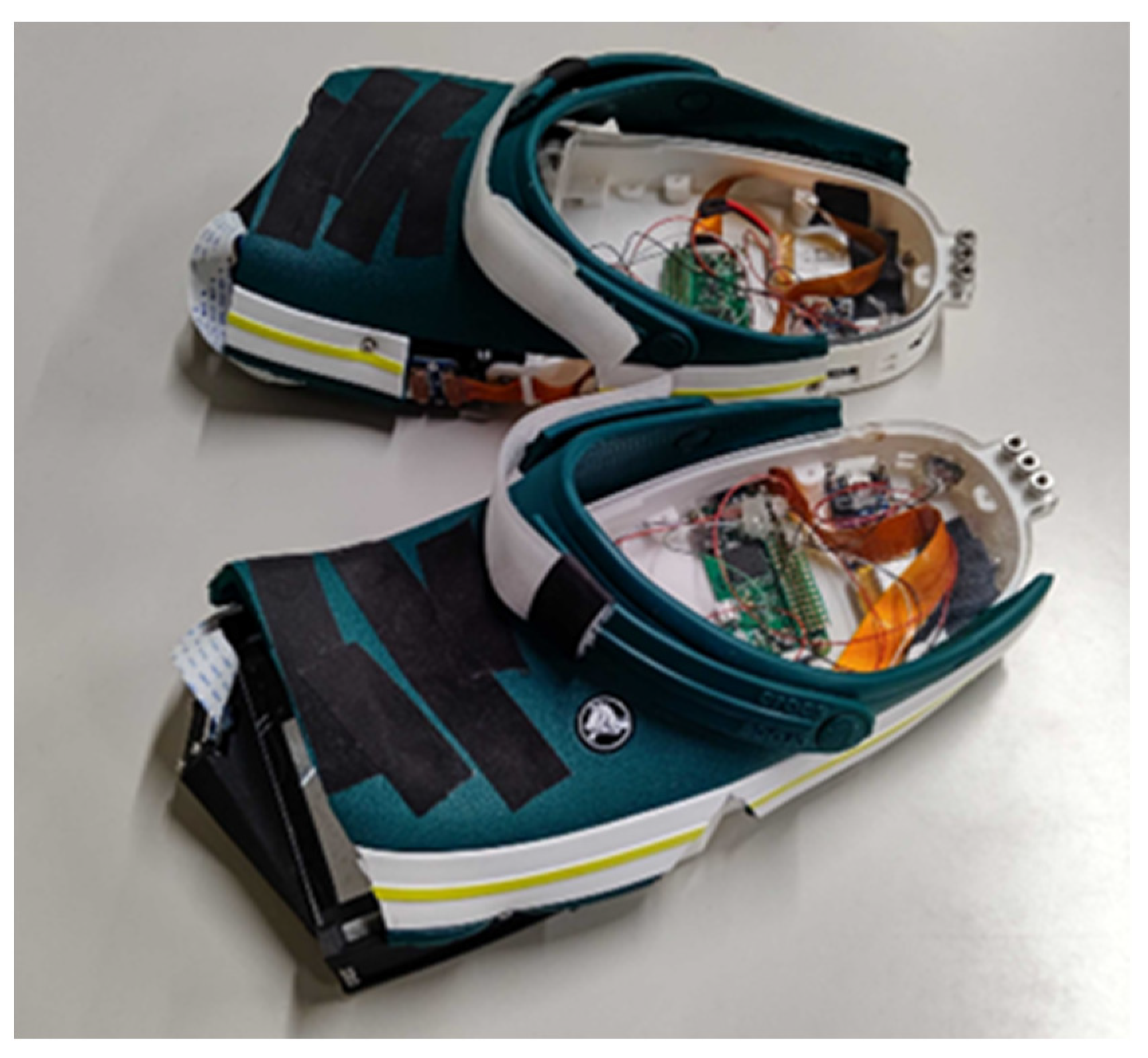
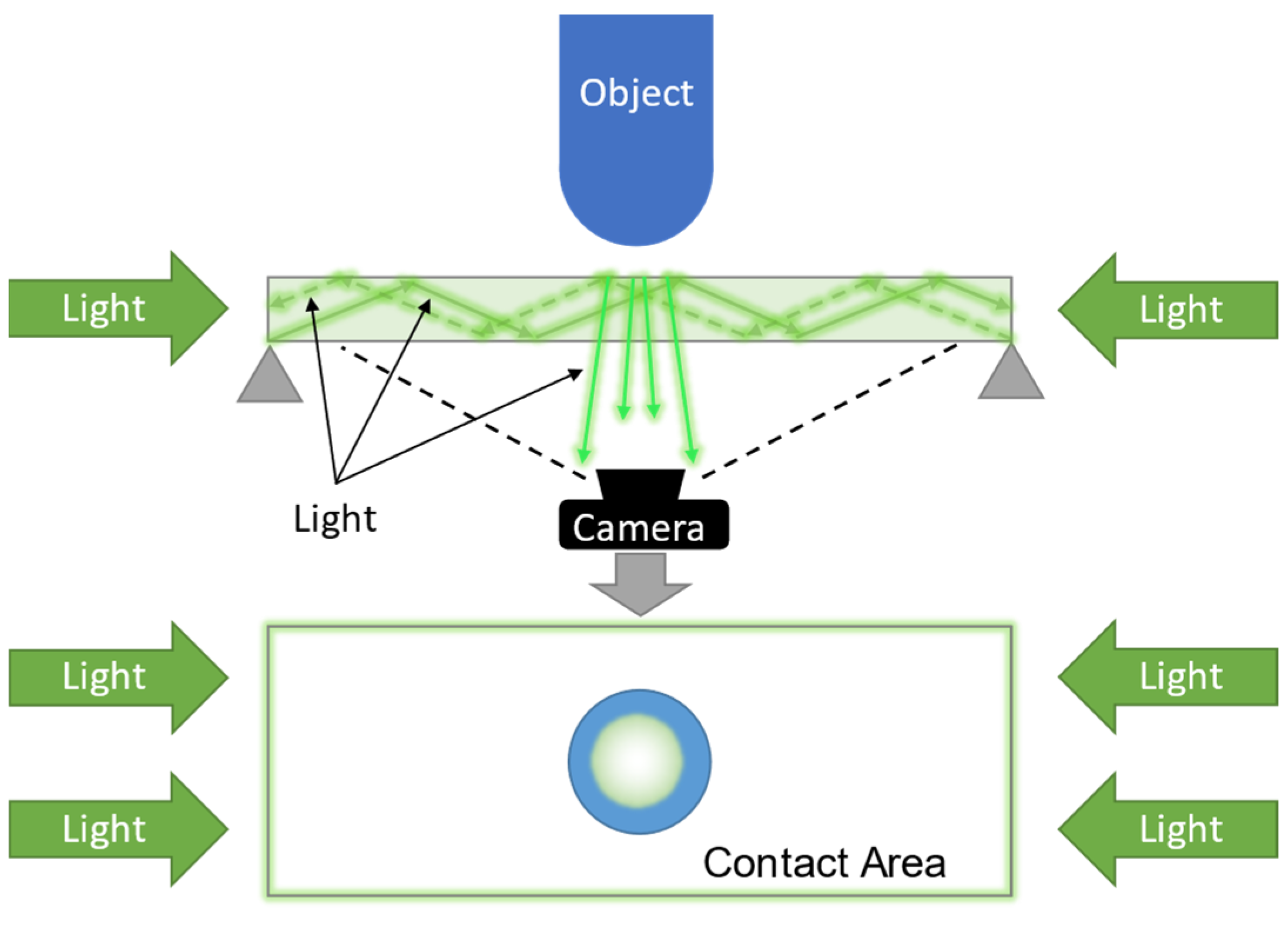
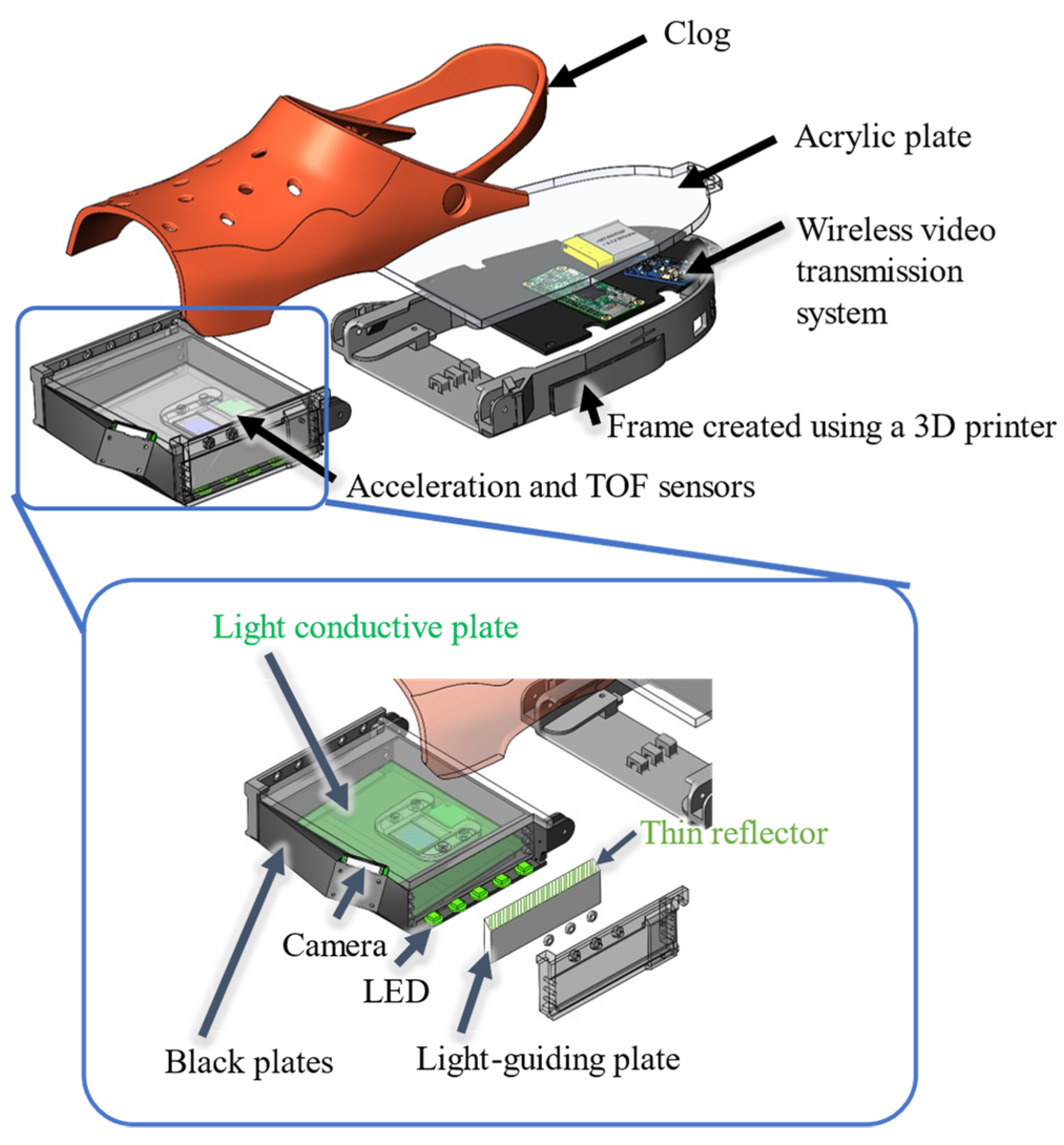

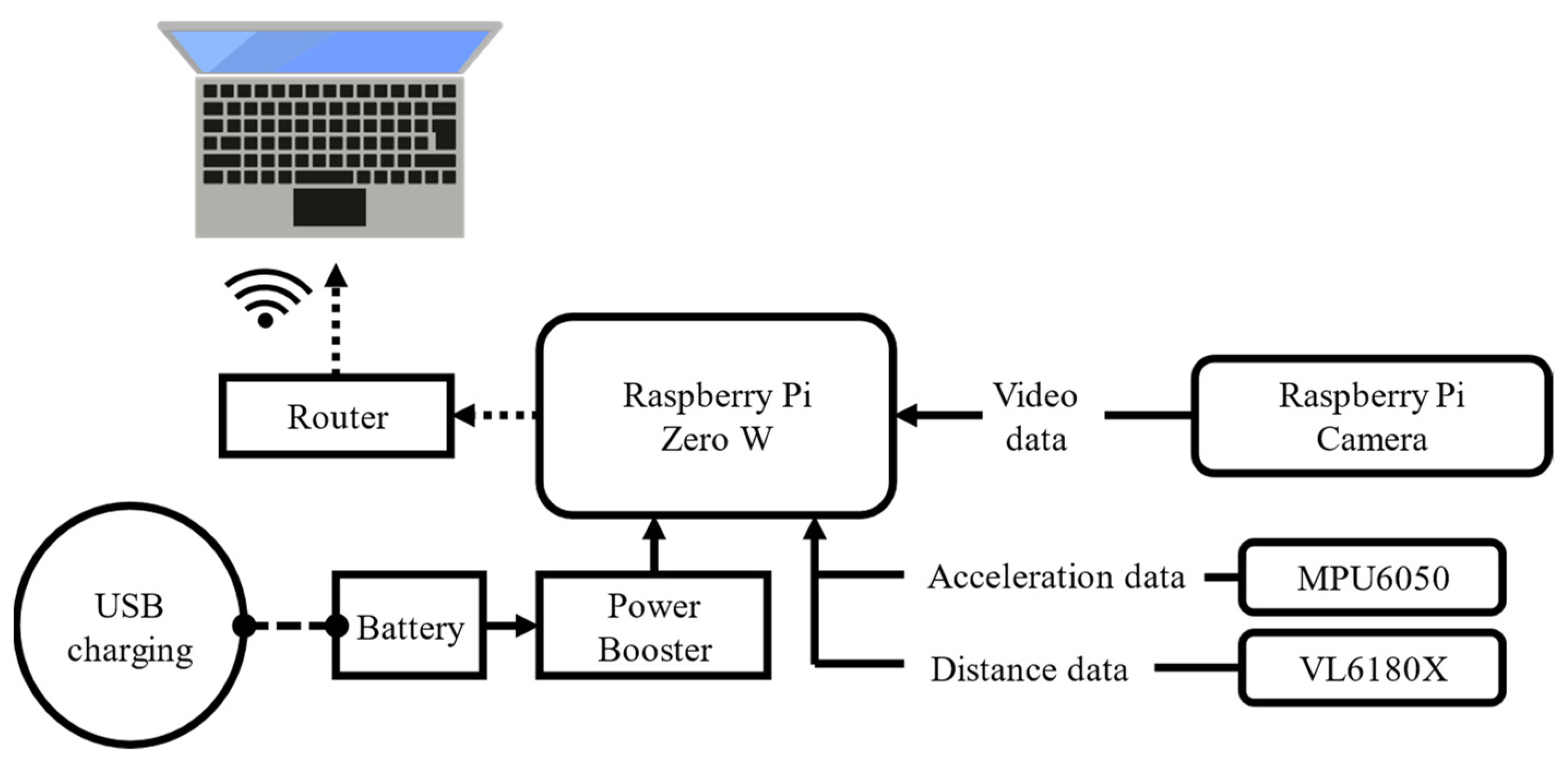

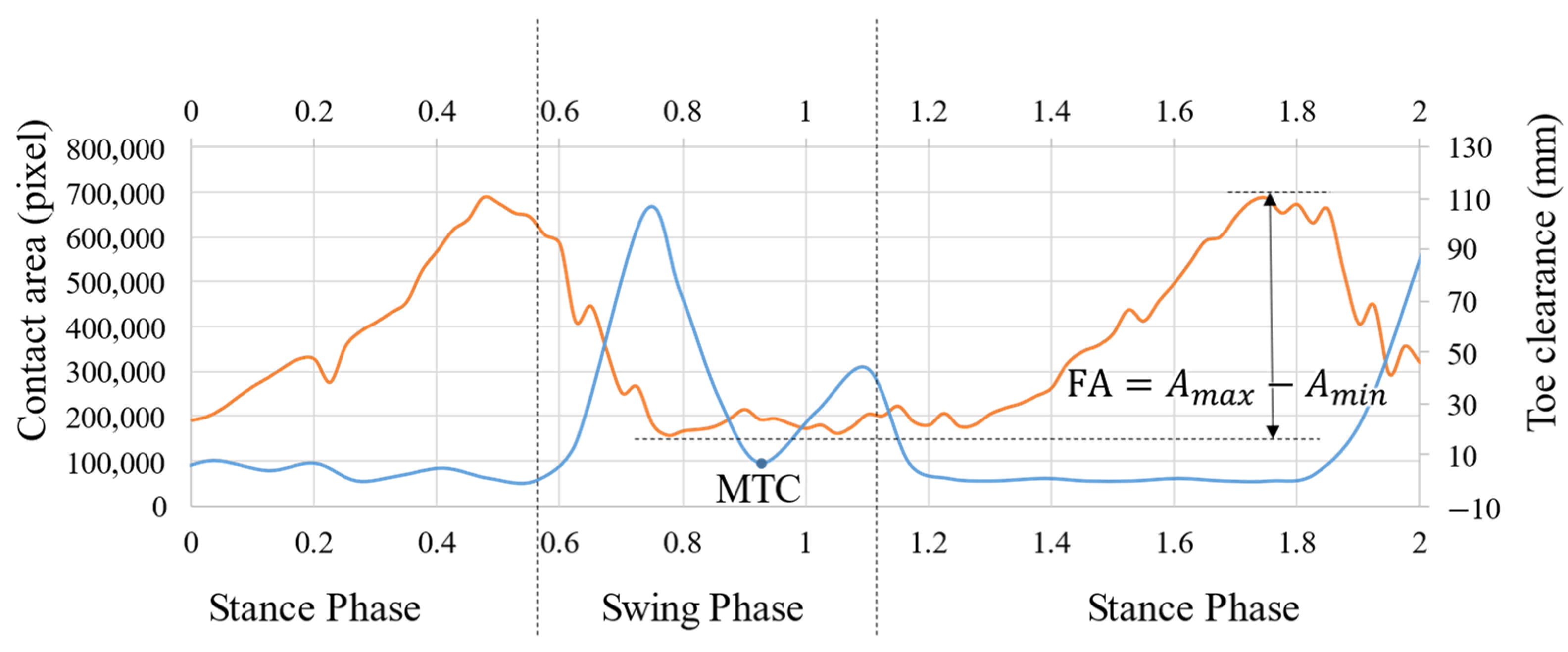
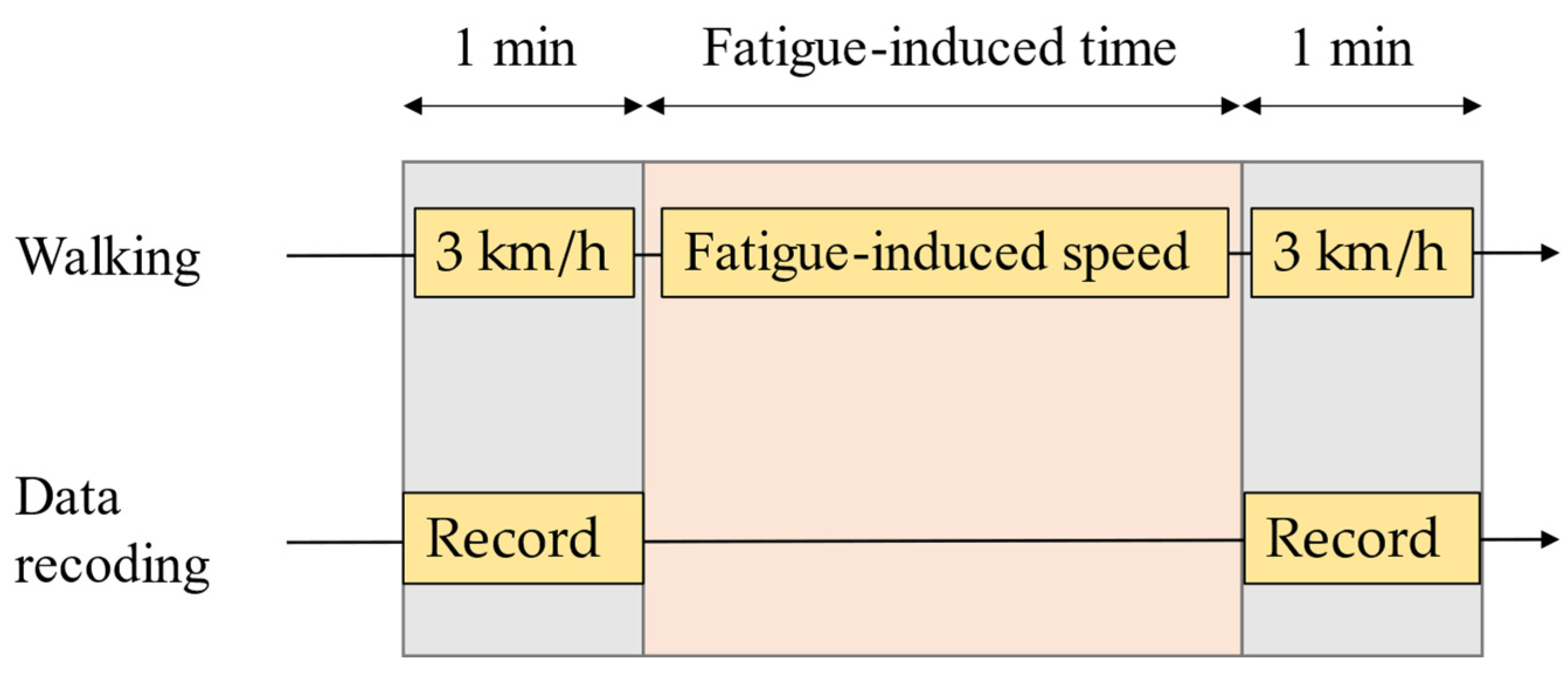


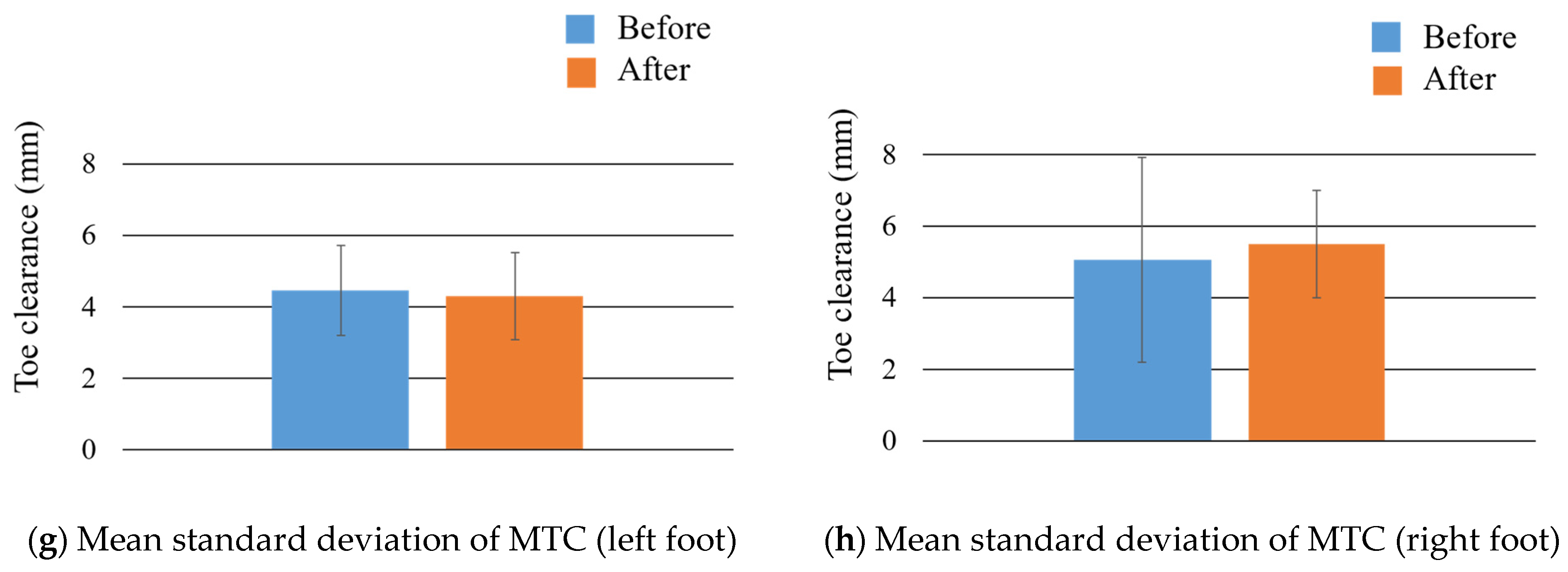
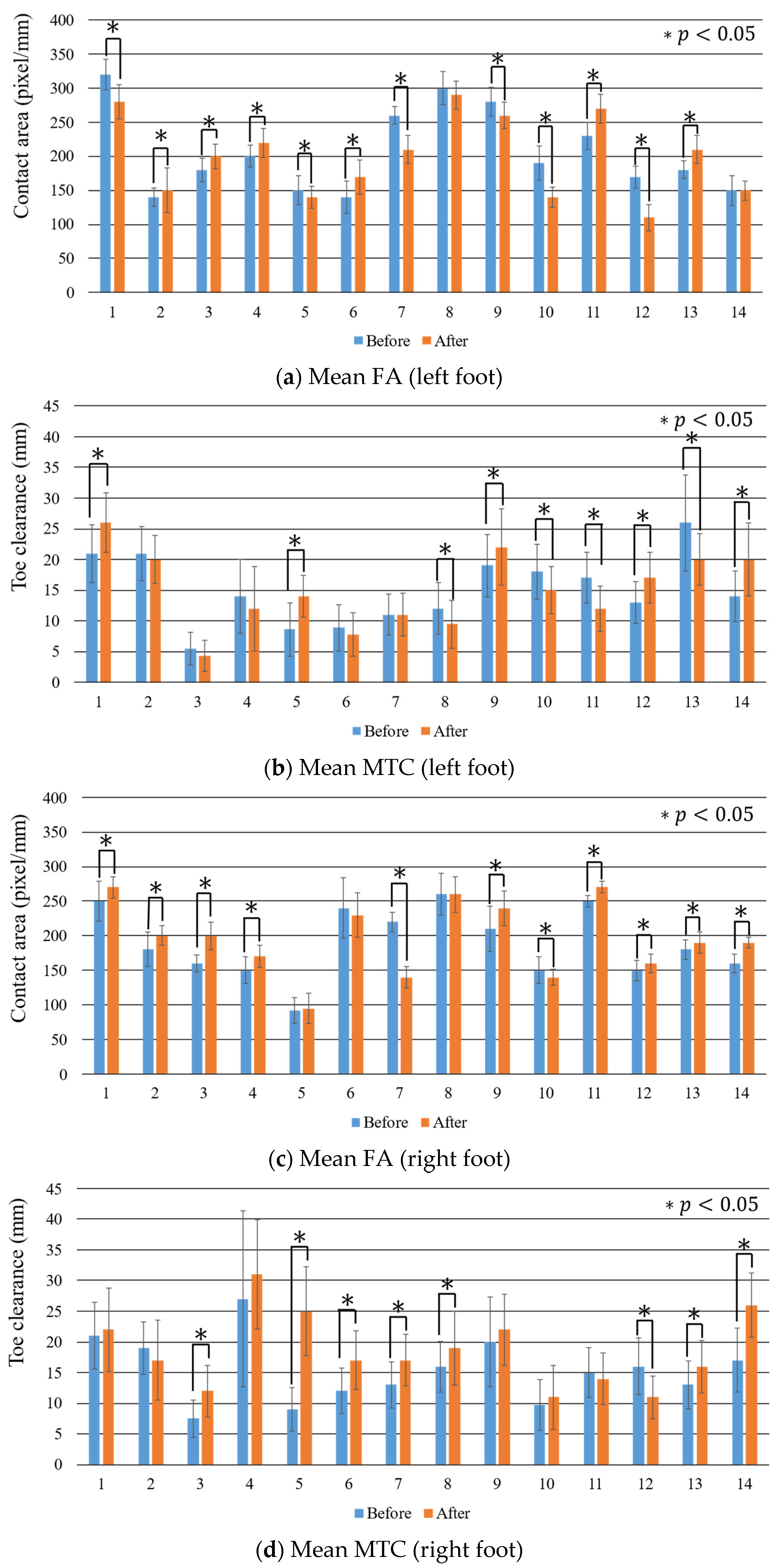
| Before | After | Rate of Change | p-Value 1 | |
|---|---|---|---|---|
| Left foot | ||||
| FA (mean (pixel/mm) ± std.) | 210 ± 62 | 200 ± 58 | 0.95 | 0.41 |
| FA (mean of std.) | 19 ± 4.3 | 21 ± 4.6 | 1.1 | 0.45 |
| MTC (mean (mm) ± std.) | 15 ± 5.7 | 15 ± 6.1 | 1.0 | 0.88 |
| MTC (mean of std.) | 4.5 ± 1.2 | 4.3 ± 1.2 | 0.96 | 0.67 |
| Right foot | ||||
| FA (mean (pixel/mm) ± std.) | 190 ± 49 | 200 ± 53 | 1.1 | 0.47 |
| FA (mean of std.) | 21 ± 9.8 | 17 ± 7.0 | 0.81 | 0.050 2 |
| MTC (mean (mm) ± std.) | 15 ± 5.2 | 19 ± 6.1 | 1.3 | 0.038 (<0.05) 2 |
| MTC (mean of std.) | 5.1 ± 2.8 | 5.5 ± 1.5 | 1.1 | 0.47 |
| (a) Left foot | ||||
| Before | After | Rate of change | p-Value 1 | |
| 1 | ||||
| FA (mean (pixel/mm) ± std.) | 320 ± 22 | 280 ± 25 | 0.88 | 0.0002 |
| MTC (mean (mm) ± std.) | 21 ± 4.7 | 26 ± 4.9 | 1.2 | 0.0002 |
| 2 | ||||
| FA (mean (pixel/mm) ± std.) | 140 ± 13 | 150 ± 33 | 1.1 | 0.0222 |
| MTC (mean (mm) ± std.) | 21 ± 4.4 | 20 ± 3.9 | 0.95 | 0.77 |
| 3 | ||||
| FA (mean (pixel/mm) ± std.) | 180 ± 17 | 200 ± 18 | 1.1 | 0.0002 |
| MTC (mean (mm) ± std.) | 5.5 ± 2.7 | 4.3 ± 2.5 | 0.78 | 0.27 |
| 4 | ||||
| FA (mean (pixel/mm) ± std.) | 200 ± 16 | 220 ± 21 | 1.1 | 0.0002 |
| MTC (mean (mm) ± std.) | 14 ± 6.0 | 12 ± 6.9 | 0.86 | 0.19 |
| 5 | ||||
| FA (mean (pixel/mm) ± std.) | 150 ± 21 | 140 ± 16 | 0.93 | 0.0012 |
| MTC (mean (mm) ± std.) | 8.6 ± 4.3 | 14 ± 3.4 | 1.6 | 0.0002 |
| 6 | ||||
| FA (mean (pixel/mm) ± std.) | 140 ± 24 | 170 ± 25 | 1.2 | 0.0002 |
| MTC (mean (mm) ± std.) | 8.9 ± 3.8 | 7.8 ± 3.5 | 0.88 | 0.16 |
| 7 | ||||
| FA (mean (pixel/mm) ± std.) | 260 ± 13 | 210 ± 20 | 0.81 | 0.0002 |
| MTC (mean (mm) ± std.) | 11 ± 3.3 | 11 ± 3.5 | 1.0 | 0.62 |
| 8 | ||||
| FA (mean (pixel/mm) ± std.) | 300 ± 24 | 290 ± 21 | 0.97 | 0.10 |
| MTC (mean (mm) ± std.) | 12 ± 4.2 | 9.5 ± 3.9 | 0.79 | 0.00532 |
| 9 | ||||
| FA (mean (pixel/mm) ± std.) | 280 ± 21 | 260 ± 19 | 0.93 | 0.0002 |
| MTC (mean (mm) ± std.) | 19 ± 5.1 | 22 ± 6.2 | 1.2 | 0.0402 |
| 10 | ||||
| FA (mean (pixel/mm) ± std.) | 190 ± 25 | 140 ± 15 | 0.74 | 0.0002 |
| MTC (mean (mm) ± std.) | 18 ± 4.5 | 15 ± 3.8 | 0.83 | 0.00112 |
| 11 | ||||
| FA (mean (pixel/mm) ± std.) | 230 ± 20 | 270 ± 21 | 1.2 | 0.0002 |
| MTC (mean (mm) ± std.) | 17 ± 4.1 | 12 ± 3.7 | 0.71 | 0.0002 |
| 12 | ||||
| FA (mean (pixel/mm) ± std.) | 170 ± 16 | 110 ± 19 | 0.65 | 0.0002 |
| MTC (mean (mm) ± std.) | 13 ± 3.4 | 17 ± 4.1 | 1.30 | 0.0002 |
| 13 | ||||
| FA (mean (pixel/mm) ± std.) | 180 ± 13 | 210 ± 20 | 1.2 | 0.0002 |
| MTC (mean (mm) ± std.) | 26 ± 7.8 | 20 ± 4.2 | 0.77 | 0.0192 |
| 14 | ||||
| FA (mean (pixel/mm) ± std.) | 150 ± 22 | 150 ± 14 | 1.0 | 0.52 |
| MTC (mean (mm) ± std.) | 14 ± 4.1 | 20 ± 5.9 | 1.4 | 0.00222 |
| (b) Right foot | ||||
| Before | After | Rate of change | p-Value 1 | |
| 1 | ||||
| FA (mean (pixel/mm) ± std.) | 250 ± 29 | 270 ± 16 | 1.1 | 0.00322 |
| MTC (mean (mm) ± std.) | 21 ± 5.4 | 22 ± 6.8 | 1.0 | 0.30 |
| 2 | ||||
| FA (mean (pixel/mm) ± std.) | 180 ± 25 | 200 ± 14 | 1.1 | 0.0002 |
| MTC (mean (mm) ± std.) | 19 ± 4.2 | 17 ± 6.5 | 0.89 | 0.19 |
| 3 | ||||
| FA (mean (pixel/mm) ± std.) | 160 ± 12 | 190 ± 20 | 1.2 | 0.0002 |
| MTC (mean (mm) ± std.) | 7.5 ± 3.0 | 12 ± 4.2 | 1.6 | 0.000 |
| 4 | ||||
| FA (mean (pixel/mm) ± std.) | 150 ± 19 | 170 ± 16 | 1.1 | 0.0002 |
| MTC (mean (mm) ± std.) | 27 ± 14 | 31 ± 8.9 | 1.1 | 0.20 |
| 5 | ||||
| FA (mean (pixel/mm) ± std.) | 92 ± 19 | 95 ± 22 | 1.0 | 0.55 |
| MTC (mean (mm) ± std.) | 9.0 ± 3.6 | 25 ± 7.3 | 2.8 | 0.0002 |
| 6 | ||||
| FA (mean (pixel/mm) ± std.) | 240 ± 44 | 230 ± 32 | 0.96 | 0.23 |
| MTC (mean (mm) ± std.) | 12 ± 3.7 | 17 ± 4.8 | 1.4 | 0.0002 |
| 7 | ||||
| FA (mean (pixel/mm) ± std.) | 220 ± 14 | 140 ± 16 | 0.64 | 0.0002 |
| MTC (mean (mm) ± std.) | 13 ± 3.8 | 17 ± 4.2 | 1.3 | 0.0002 |
| 8 | ||||
| FA (mean (pixel/mm) ± std.) | 260 ± 30 | 260 ± 26 | 1.0 | 0.98 |
| MTC (mean (mm) ± std.) | 16 ± 4.1 | 19 ± 6.0 | 1.2 | 0.0122 |
| 9 | ||||
| FA (mean (pixel/mm) ± std.) | 210 ± 33 | 240 ± 25 | 1.1 | 0.0002 |
| MTC (mean (mm) ± std.) | 20 ± 7.3 | 22 ± 5.8 | 1.1 | 0.15 |
| 10 | ||||
| FA (mean (pixel/mm) ± std.) | 150 ± 19 | 140 ± 11 | 0.93 | 0.0002 |
| MTC (mean (mm) ± std.) | 9.7 ± 4.1 | 11 ± 5.2 | 1.1 | 0.32 |
| 11 | ||||
| FA (mean (pixel/mm) ± std.) | 250 ± 8.6 | 270 ± 8.4 | 1.1 | 0.0002 |
| MTC (mean (mm) ± std.) | 15 ± 4.0 | 14 ± 4.2 | 0.93 | 0.063 |
| 12 | ||||
| FA (mean (pixel/mm) ± std.) | 150 ± 15 | 160 ± 14 | 1.1 | 0.00542 |
| MTC (mean (mm) ± std.) | 16 ± 4.6 | 11 ± 3.5 | 0.69 | 0.0002 |
| 13 | ||||
| FA (mean (pixel/mm) ± std.) | 180 ± 14 | 190 ± 15 | 1.1 | 0.0212 |
| MTC (mean (mm) ± std.) | 13 ± 3.9 | 16 ± 4.3 | 1.2 | 0.0402 |
| 14 | ||||
| FA (mean (pixel/mm) ± std.) | 160 ± 14 | 190 ± 7.3 | 1.2 | 0.0002 |
| MTC (mean (mm) ± std.) | 17 ± 5.2 | 26 ± 5.2 | 1.5 | 0.0002 |
| (a) Left foot | |||||
| MTC | Subtotal (FA) | ||||
| Up | Down | - | |||
| FA | Up | 0 | 2 | 4 | 6 |
| Down | 4 | 1 | 1 | 6 | |
| - | 1 | 1 | 0 | 2 | |
| Subtotal (MTC) | 5 | 4 | 5 | ||
| (b) Right foot | |||||
| MTC | Subtotal (FA) | ||||
| Up | Down | - | |||
| FA | Up | 3 | 1 | 5 | 9 |
| Down | 1 | 0 | 1 | 2 | |
| - | 3 | 0 | 0 | 3 | |
| Subtotal (MTC) | 7 | 1 | 6 | ||
Publisher’s Note: MDPI stays neutral with regard to jurisdictional claims in published maps and institutional affiliations. |
© 2022 by the authors. Licensee MDPI, Basel, Switzerland. This article is an open access article distributed under the terms and conditions of the Creative Commons Attribution (CC BY) license (https://creativecommons.org/licenses/by/4.0/).
Share and Cite
Jin, Y.; Sano, Y.; Shogenji, M.; Watanabe, T. Fatigue Effect on Minimal Toe Clearance and Toe Activity during Walking. Sensors 2022, 22, 9300. https://doi.org/10.3390/s22239300
Jin Y, Sano Y, Shogenji M, Watanabe T. Fatigue Effect on Minimal Toe Clearance and Toe Activity during Walking. Sensors. 2022; 22(23):9300. https://doi.org/10.3390/s22239300
Chicago/Turabian StyleJin, Yingjie, Yui Sano, Miho Shogenji, and Tetsuyou Watanabe. 2022. "Fatigue Effect on Minimal Toe Clearance and Toe Activity during Walking" Sensors 22, no. 23: 9300. https://doi.org/10.3390/s22239300
APA StyleJin, Y., Sano, Y., Shogenji, M., & Watanabe, T. (2022). Fatigue Effect on Minimal Toe Clearance and Toe Activity during Walking. Sensors, 22(23), 9300. https://doi.org/10.3390/s22239300






